Roll-away nest boxes are an essential component of any poultry farm, especially for those who raise egg-laying hens. These specialized nesting areas are designed to make the process of collecting eggs more convenient and hygienic.
Unlike traditional open-style nests, roll-away nest boxes have a sloped floor that allows eggs to roll out of the box as soon as they are laid, thus preventing them from being trampled or soiled by the hens. This also makes it easier for farmers to collect eggs without disturbing the nesting hens.

But why should you bother making roll-away nest boxes when traditional nests seem to do just fine? Well, for starters, roll-away nest boxes can significantly improve egg cleanliness and reduce the risk of disease transmission.
Additionally, it can also save you time and effort in collecting eggs as they are neatly laid out in a separate tray or compartment. In this guide, we will walk you through the steps on how to make roll away nest boxes for your poultry farm.
Understanding Roll-Away Nest Boxes
Before diving into the construction process, it’s essential to understand how roll-away nest boxes work. As mentioned earlier, these nests have a sloped floor that allows eggs to roll out of the nest as soon as they are laid.
This design prevents the hens from pecking and soiling the eggs, which can lead to contamination and reduced hatchability. The eggs then roll onto a separate tray or compartment, where they are collected by the farmer.
Apart from the sloped floor, roll-away nest boxes also have a curved entrance that encourages hens to enter and lay their eggs. The boxes should be large enough to accommodate one hen at a time comfortably, as overcrowding can cause stress and may discourage egg-laying. Additionally, the boxes should have a sturdy and secure construction to prevent them from toppling over or being damaged by the hens.
Tools and Materials You Will Need to Make Roll Away Nest Boxes
1. Plywood sheets (preferably 1/2 inch thick)
2. Screws or nails
3. Saw
4. Measuring tape
5. Drill
6. Hammer
7. Hinges
8. Latches
9. Mesh wire or hardware cloth
10. Roofing material (e.g., corrugated metal, shingles)
Step-by-step Guidelines on How to Make Roll Away Nest Boxes
Step 1: Design and Measurements
Before starting the construction process, you need to have a clear idea of how your roll-away nest boxes will look like. You can either create your design or use pre-existing plans available online. Once you have a blueprint in mind, measure and mark the dimensions on the plywood sheets according to your desired box size. This step will help you determine the number of sheets you will need for each nest box.
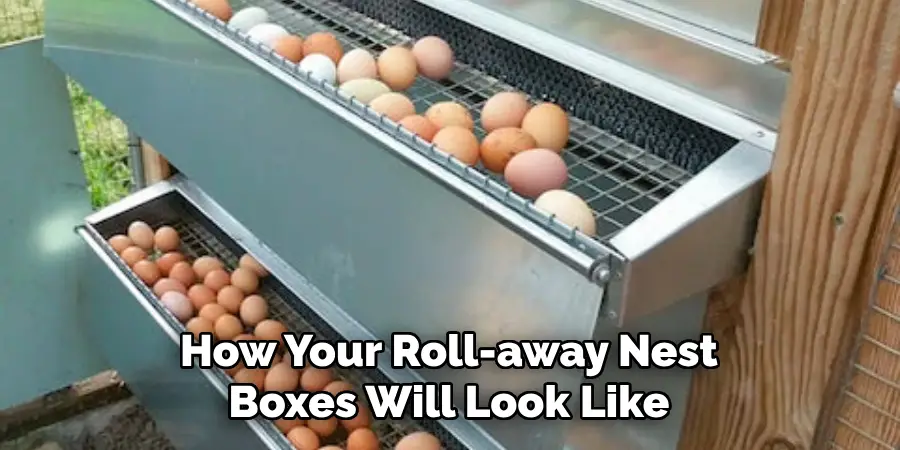
Step 2: Cut the Plywood Sheets
Using a saw, cut the plywood sheets according to your measurements. Make sure to have precise cuts for a snug fit when assembling the boxes later on. While cutting, keep in mind that you will need two identical pieces for each nest box. Make additional cuts for the curved entrance and sloped floor, as well as the lid or roof if desired.
Step 3: Assemble the Box
Once all the necessary pieces are cut, it’s time to assemble the box. Start by attaching the two identical pieces of plywood using screws or nails. Next, attach the curved entrance at one end of the box and the sloped floor at the other. You can also add a lid or roof to keep the nesting hens protected from weather elements. If using a lid, make sure it can be easily opened for egg collection.
Step 4: Add Hinges and Latches
To make it easier for egg collection, attach hinges at the bottom of the box and secure them with screws. This will allow the tray or compartment where eggs roll out to be easily accessible for collection. Additionally, add latches at the top of the box to keep it securely closed and prevent hens from entering.
Step 5: Install the Mesh Wire
To prevent eggs from dropping onto the ground and getting soiled, install mesh wire or hardware cloth on the sloped floor of the nest box. This will allow eggs to roll out but also provide enough support for the hens to stand on while laying their eggs. While attaching the wire, make sure there are no gaps that could potentially trap or injure the hens.

Step 6: Finishing Touches
To ensure stability and durability, reinforce the corners of the box using additional screws or nails. You can also add a coat of paint to protect the wood from weather elements and make it visually appealing. Finally, place straw or other nesting materials inside the box to make it comfortable and inviting for the hens. Make sure to clean and replace the nesting material regularly.
Following these steps, you can easily make your roll-away nest boxes for your poultry farm. Remember to regularly inspect and maintain the boxes to ensure they are in good condition and provide a comfortable place for your hens to lay their eggs.
With proper construction and care, roll-away nest boxes can be a valuable addition to any poultry farm, improving egg cleanliness and making egg collection more efficient. So why not give it a try and see the difference for yourself? Happy farming!
Additional Tips and Tricks to Make Roll Away Nest Boxes
1. If possible, use a hinged lid on your roll-away nest boxes so that you can easily access the eggs and clean out the box when necessary. This will also help prevent any unwanted pests from nesting in the box.
2. Consider adding a slanted roof to your roll-away nest box to allow for water runoff and prevent any potential leakage.
3. Place some soft bedding, such as straw or wood shavings, inside the nest box to make it more comfortable for the hens and encourage them to lay their eggs there. This will also help protect the eggs from breaking.
4. Keep the nest box area clean and free of any debris or droppings to maintain a hygienic environment for your hens and their eggs.
5. Install a divider inside the nest box if you have multiple hens using it. This can help prevent them from disturbing each other’s eggs and reduce competition for the nest box.
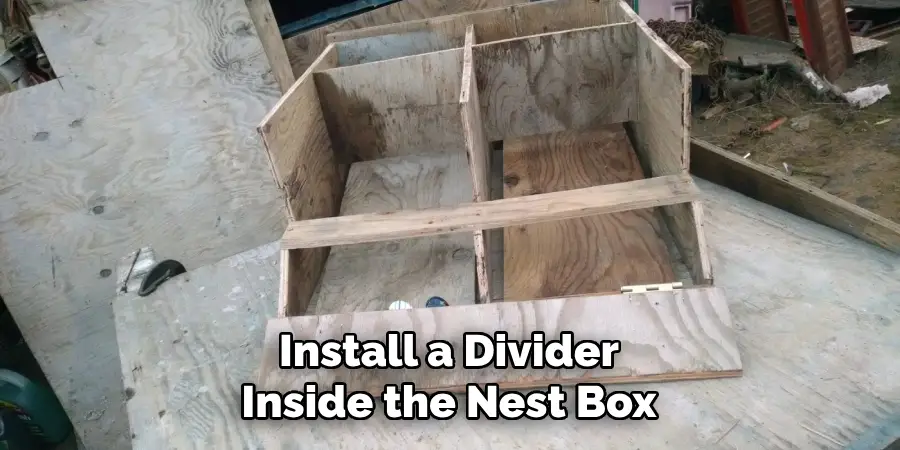
6. Consider placing some fake eggs or golf balls in the nest box to encourage your hens to lay their eggs there. The sight of existing eggs can often trigger a hen’s instinct to lay her own.
7. Regularly check and adjust the nesting material in the box to ensure it stays clean and dry for your hens.
8. If using a roll-away nest box, make sure to regularly check and clean the collecting tray underneath to prevent any buildup of dirt or droppings.
9. Place your roll-away nest boxes in a shaded area to help keep the eggs cool and prevent them from spoiling too quickly.
10. If you have multiple nesting areas for your hens, consider rotating which box is available for use to prevent overcrowding and encourage the hens to lay in different locations.
By following these additional tips and tricks, you can ensure that your roll-away nest boxes are not only functional but also provide a comfortable and hygienic environment for your hens to lay their eggs. Remember to regularly check and maintain the boxes to keep them in optimal condition for your feathered friends. Happy nesting!
Things You Should Consider to Make Roll Away Nest Boxes
1. The first thing you should consider when making roll-away nest boxes is the material. It should be sturdy and durable enough to withstand the weight of the chickens and their eggs. Wood is a popular choice for its strength and affordability, but metal or plastic can also be used.
2. Another important factor to consider is the size of the nest boxes. They should be large enough for your chickens to comfortably enter and lay their eggs, but not too big that they may feel exposed or vulnerable. A good rule of thumb is to have a minimum of 1 square foot of space per chicken.
3. It’s also important to consider the angle of the nest boxes. They should be tilted downwards at a slight angle towards the front opening to allow for easy egg collection and prevent eggs from rolling out. This can also help with keeping the nest boxes clean as any debris or waste will naturally roll out.
4. The location of the roll-away nest boxes is another crucial consideration. They should be placed in a quiet and protected area, away from high-traffic areas and noisy machinery. Chickens prefer privacy when laying eggs, so choose a spot that provides them with some seclusion.
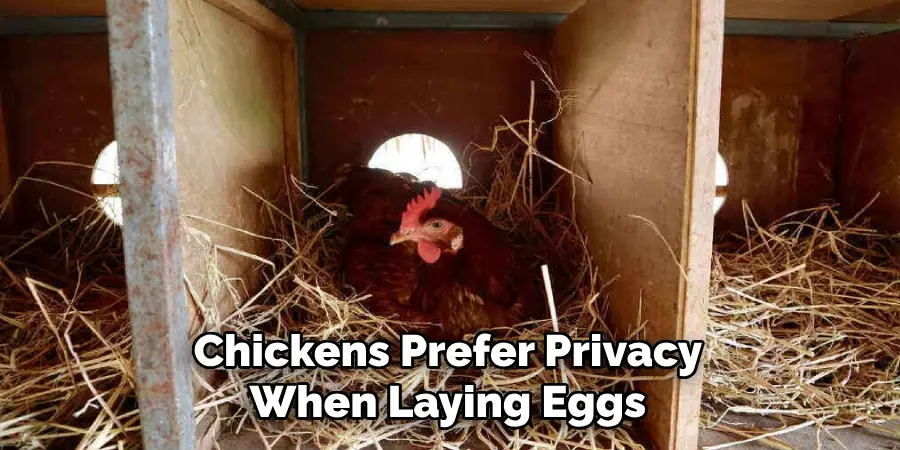
5. Ventilation is also important for the health of your chickens. Make sure the nest boxes have proper ventilation to prevent moisture buildup which can lead to mold and bacteria growth. This can be achieved through the use of vents or wire mesh on the sides of the nest boxes.
6. Consider adding a perch inside the nest box for chickens to comfortably rest while they lay their eggs. This can also help prevent them from stepping on their eggs and breaking them.
7. The design of the roll-away nest boxes should also take into account ease of cleaning. Make sure there are no small crevices where dirt and debris can accumulate, and consider adding a removable tray or liner for easy clean-up.
8. Finally, think about the number of nest boxes needed based on the size of your flock. Chickens tend to prefer laying in the same spot, so having multiple nest boxes will prevent overcrowding and competition amongst the hens. As a general rule, have one nest box for every 4-5 chickens.
Following these considerations can help you create functional and efficient roll-away nest boxes for your chickens. Remember to regularly clean and maintain the nest boxes to ensure a happy and healthy flock. Happy nesting!
Maintenance Tips for Roll Away Nest Boxes
1. Regular Cleaning:
Just like with any other chicken coop equipment, regular cleaning is essential to ensure the hygiene of your roll-away nest boxes. This involves removing any leftover eggs, feathers, and droppings from the nesting area. Using a mild detergent and water, scrub the inside of the nest box and rinse thoroughly. Allow it to dry before adding new bedding.
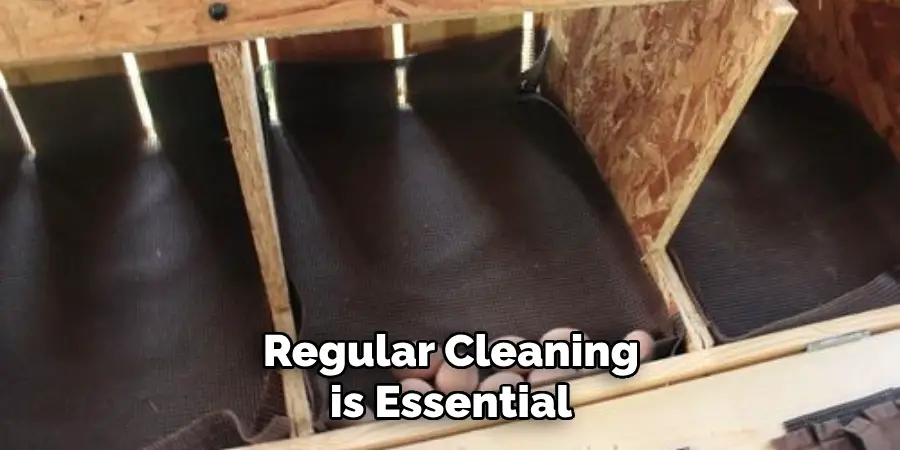
It is recommended to clean the nest boxes at least once a week. This will prevent any build-up of bacteria, mold, or parasites that can harm your chickens and impact egg production.
2. Monitoring Egg Quality:
One of the main benefits of using roll-away nest boxes is to keep eggs clean and reduce the risk of breakage. However, it is still important to regularly check the quality of the eggs being collected. Make sure there are no cracks or abnormalities in the shells. This can indicate a problem with the nesting material or the positioning of the nest box.
Additionally, pay attention to any changes in egg size or shape as this could be a sign of stress or health issues in your hens. Addressing any issues early on can prevent further problems and ensure the overall health of your flock.
3. Inspecting for Wear and Tear:
Roll-away nest boxes are typically made from durable materials such as metal or plastic, but they still require regular inspections for wear and tear. Check for any cracks, rust, or loose parts that may need to be repaired or replaced. This includes the nesting material and any moving parts that may become stuck or worn over time.
Taking care of any maintenance issues as soon as they arise can prolong the lifespan of your roll-away nest boxes and ensure they continue to function properly.
4. Proper Bedding:
The type of bedding used in roll-away nest boxes is crucial for egg production and the overall health of your chickens. Avoid using materials that are too hard, such as straw or hay, as they can cause discomfort for hens and potentially damage eggs. Instead, use soft materials like wood shavings or shredded paper.
It is also important to regularly replace the bedding to maintain cleanliness and prevent any health hazards for your flock.
5. Positioning:
Proper positioning of roll-away nest boxes is key to their effectiveness. They should be placed in a quiet, dark area of the coop that is away from any high-traffic areas. This will help reduce stress and encourage chickens to use the nest boxes.
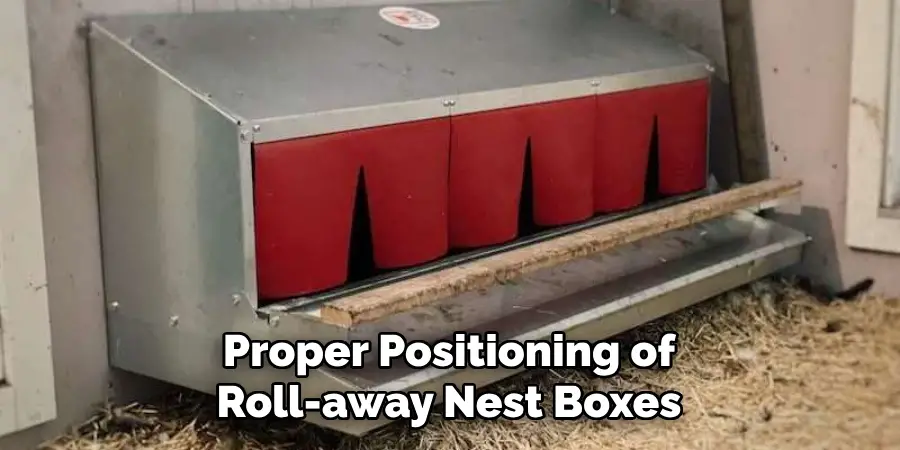
Additionally, make sure the angle of the nest box allows eggs to roll down easily without getting stuck or breaking. Adjusting the positioning may be necessary as your chickens grow and their egg-laying habits change.
6. Regular Egg Collection:
Lastly, it is important to collect eggs from roll-away nest boxes regularly. Leaving eggs in the nest box for too long can attract pests and increase the risk of breakage. It also allows for other hens to potentially peck at and damage the eggs. This can also lead to a decline in egg production. If possible, try to collect eggs at least twice a day.
By following these maintenance tips, you can ensure that your roll-away nest boxes remain in good condition and continue to provide clean, high-quality eggs for your flock. Remember to also consult the manufacturer’s instructions for specific care guidelines and recommendations. Happy egg collecting!
Frequently Asked Questions
What Are Roll Away Nest Boxes?
Roll-away nest boxes are specialized nesting areas designed for poultry, particularly chickens. These types of nest boxes work by allowing the eggs to roll out of the nesting area as soon as they are laid, preventing them from being pecked or soiled by other chickens. This also reduces the risk of cracked eggs and makes egg collection much easier.
What Precautions Should I Take Before Installing Roll-Away Nest Boxes?
Before installing roll-away nest boxes, it is important to make sure that your chickens are comfortable and familiar with their surroundings. It is recommended to wait until they have been laying eggs consistently for at least a week before introducing new nesting areas. Additionally, it is important to ensure that the area where the nest boxes will be installed is clean, well-ventilated, and easily accessible for both chickens and humans.
Are Roll Away Nest Boxes Easy to Clean and Maintain?
Yes, one of the main benefits of using roll-away nest boxes is that they are easy to clean and maintain. Most designs allow for easy removal of soiled bedding or debris, and some even have removable trays for easy cleaning. It is recommended to clean the nest boxes regularly to ensure a hygienic environment for your chickens and to prevent any potential health issues.
Can Roll Away Nest Boxes Be Used for Other Types of Poultry?
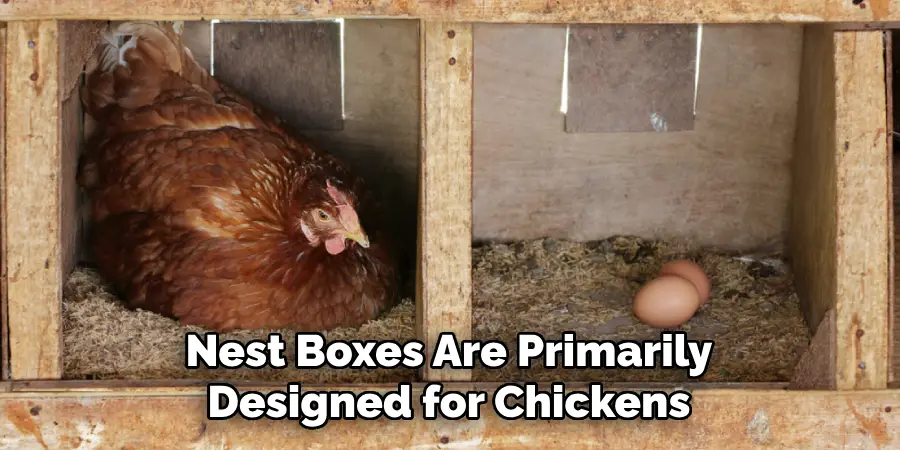
While roll-away nest boxes are primarily designed for chickens, they can also be used for other types of poultry such as ducks, geese, and turkeys. However, it is important to consider the size and needs of these birds before installing roll-away nest boxes for them. It may be necessary to make adjustments or modifications to accommodate their specific requirements.
Conclusion
Now you know how to make roll away nest boxes and some important considerations to keep in mind before installing them. By providing your chickens with comfortable and functional nesting areas, you can ensure a stress-free and productive environment for egg-laying. Remember to regularly clean and maintain the nest boxes to keep your flock healthy and happy. Happy farming!
About
Outdoor Fixes is a distinguished figure in the world of Diy design, with a decade of expertise creating innovative and sustainable Diy solutions.
His professional focus lies in merging traditional craftsmanship with modern manufacturing techniques,
fostering designs that are both practical and environmentally conscious. As the author of diy,
outdoorfixes delves into the art and science of outdoorfixes-making, inspiring artisans and industry professionals alike.
Education RMIT University
(Melbourne, Australia) Associate Degree in Design (Outdoor Fixes) Focus on sustainable design, industry-driven projects,
and practical craftsmanship. Gained hands-on experience with traditional and digital manufacturing tools, such as CAD and CNC software.
Nottingham Trent University
(United Kingdom) Bachelor’s in outdoorfixes.com and Product Design (Honors) Specialized in product design with a focus on blending creativity with production
techniques. Participated in industry projects, working with companies like John Lewis and Vitsoe to gain real-world insights.
Publications and Impact
In diy, Outdoor Fixes his insights on indoor design processes, materials, and strategies for efficient production.
His writing bridges the gap between artisan knowledge and modern industry needs, making it a must-read for both budding designers and seasoned professionals.

